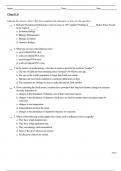Examen
Test Bank for Evolution: Making Sense of Life, 3rd Edition by Douglas Emlen
- Grado
- Institución
Test Bank for Evolution: Making Sense of Life 3e 3rd Edition by Douglas Emlen, Carl Zimmer. Full Chapters test bank are included - Chapter 1 to 18 1 The Whale and the Virus: How Scientists Study Evolution 1 2 From Natural Philosophy to Darwin: A Brief History of Evolutionary Ideas 28 3 ...
[Mostrar más]



